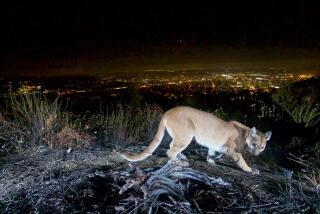Rabies puts bite on Arizona wild lands; cases rise
- Share via
TUCSON, ARIZ. — Chris Sabo was hiking in northern Arizona in mid-April when he felt teeth gripping his ankle. He thought a rattler was biting him.
But latched onto his foot was a rabid gray fox, probably the same one that had bitten a Massachusetts man three times scarcely an hour before.
Sabo captured his persistent attacker by stepping on its neck and holding it down. “It was obvious it wasn’t in its right mind,” he said.
Across Arizona, there have been an above-normal 54 cases of rabies reported since January, some of them, like Sabo’s encounter with the fox, involving attacks on people. State and national experts say the state’s record of 169 cases in 2005 is likely to be broken.
Arizona’s surging population and increase in the number of pets -- which can be prey for carnivores -- have been factors in the state’s soaring rabies cases, said Dr. Charles Rupprecht, chief of the rabies program with the federal Centers for Disease Control and Prevention in Atlanta.
Not only are there more people outdoors and in recreational areas who can report seeing wild animals acting unnaturally, but the environmental landscape has been altered dramatically as development pushes into wilderness areas, leading to more incidents between humans and animals, said Rupprecht and David Bergman, also a federal official.
Bergman is Arizona director for the U.S. Department of Agriculture’s Animal and Plant Health Inspection Service-Wildlife Services.
In the Arizona cases reported as of late April, 19 people and 64 domestic animals were exposed to animals with confirmed cases of rabies. They included attacks by six animals on nine people.
Among the attacks were a nationally publicized case in which a rabid mountain lion scratched a 10-year-old boy at a Tonto National Forest trail head north of Phoenix in March before an adult who was with him fatally shot the cat.
Nine people who were with the boy had to be vaccinated against rabies because they had touched the animal without gloves after it was dead.
The mountain lion attack was a rare incident, said Dr. Elisabeth Lawaczeck, Arizona’s public health veterinarian: “You’re more likely to be struck by lightning.”
In April, two University of Arizona scientists hiking in the Santa Rita Mountains south of Tucson were bitten by a rabid bobcat before one of them bludgeoned the animal to death with a geologist’s hammer. Both received treatment.
Sabo, who works at the Deschutes National Forest in central Oregon’s Cascade Mountain range, had his run-in with the rabid fox about three days before the bobcat incident.
He said he used a stick to pry the fox’s teeth from his sock and expected the animal to run off. But it came at him again, and he “stomped on its neck” and pinned it with a foot while he tied a rope to the fox and then hung it over a tree branch.
The fox had died by the time an animal control officer arrived 90 minutes later.
Sabo had to receive shots of rabies vaccine after the attack and had to be injected with rabies immune globulin around the bite site to provide antibodies immediately -- a standard treatment in such cases.
Rabies is nearly always fatal if medical attention is not provided immediately.
Rupprecht, the CDC official, said there currently are a couple of “hot spots around the country” for rabies.
Arizona, New Mexico and parts of Texas are experiencing outbreaks among gray foxes. Arizona is the only Southwest state that also has rabies cases among skunks. Arizona seems to be leading the way.
“It’s a little unusual for this third of a year to have that number of cases, when you consider that most of the cases should occur now through the fall,” Rupprecht said.
More to Read
Sign up for Essential California
The most important California stories and recommendations in your inbox every morning.
You may occasionally receive promotional content from the Los Angeles Times.










